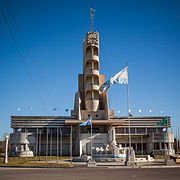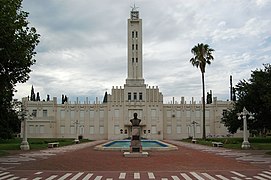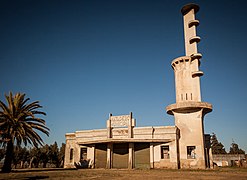|
Francisco Salamone
Francisco Salamone (June 5, 1897 – August 8, 1959) was an Argentine architect born in Italy who, between 1936 and 1940, during the Infamous Decade, built more than 60 municipal buildings with elements of Art Deco style in 25 rural communities on the Argentine pampas within the Buenos Aires Province. These buildings were some of the first examples of modern architecture in rural Argentina. LifeSalamone's was born in the town of Leonforte, Sicily in 1897, son of Salvatore Salamone and Antonia D'Anna.[1] After leaving the Otto Krause Technical School in Buenos Aires he continued his studies in the National University of Córdoba where he graduated in 1917 with a degree in architecture and civil engineering. Salamone married Adolfina Croft, the daughter of the Austria-Hungarian Vice-consul in Bahia Blanca, Argentina, with whom he had four children: Ricardo, Roberto, Ana Maria and Stella Maris. During Manuel Fresco's term, a conservative politician who was governor of the Province of Buenos Aires during the period 1936-1940, Salamone built more than 70 municipal buildings. His designs were a notable and very personal combination of Art Deco functionalism, Italian Futurism on a vast scale. The use of reinforced concrete made it possible to construct buildings to a height that at that time made them symbols of municipal power and authority. The rural towns in which Salamone's buildings appeared were either frontier towns, built at the end of the nineteenth century on the edge of Indian territory, or were situated at regular intervals along newly built rail links. These towns were named after the colonels and generals who led the Conquest of the Desert and engineers who pioneered the building of the railways in this part of the Province. In the 1950s, Salamone designed several condominiums in Rationist style. He died on 8 August 1959, relatively forgotten, but leaving behind him a monumental architectural inheritance on the Argentine pampas. He was buried in Recoleta Cemetery and later transferred to Cemetery Jardin de Paz. BuildingsSalamone's work comprised three types of municipal buildings:
WorksCity halls
Slaughterhouses
Cemetery portals
References
External linksWikimedia Commons has media related to Francisco Salamone.
|
||||||||||||||||||||















